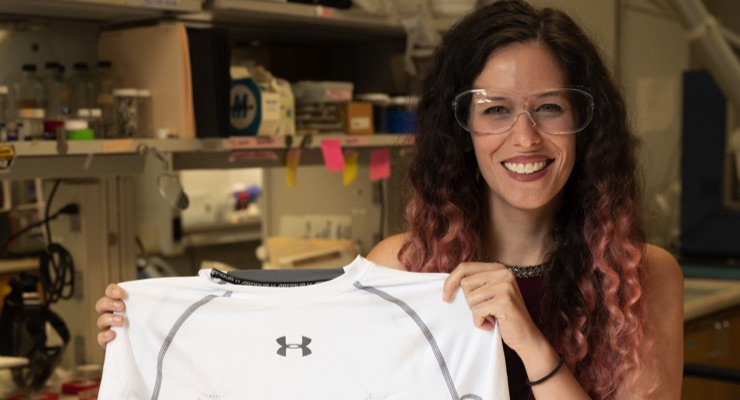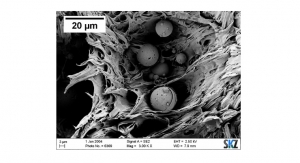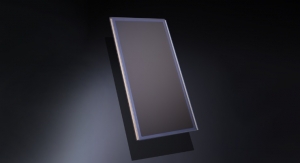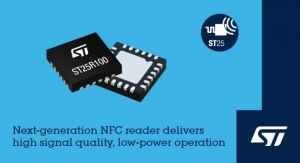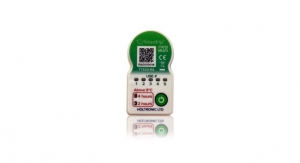Mike Williams, Rice University08.31.21
There’s no need to don uncomfortable smartwatches or chest straps to monitor your heart if your comfy shirt can do a better job.
That’s the idea behind “smart clothing” developed by a Rice University lab, which employed its conductive nanotube thread to weave functionality into regular apparel.
The Brown School of Engineering lab of chemical and biomolecular engineer Matteo Pasquali reported in the American Chemical Society journal Nano Letters that it sewed nanotube fibers into athletic wear to monitor the heart rate and take a continual electrocardiogram (EKG) of the wearer.
The fibers are just as conductive as metal wires, but washable, comfortable and far less likely to break when a body is in motion, according to the researchers.
On the whole, the shirt they enhanced was better at gathering data than a standard chest-strap monitor taking live measurements during experiments. When matched with commercial medical electrode monitors, the carbon nanotube shirt gave slightly better EKGs.
“The shirt has to be snug against the chest,” said Rice graduate student Lauren Taylor, lead author of the study. “In future studies, we will focus on using denser patches of carbon nanotube threads so there’s more surface area to contact the skin.”
The researchers noted nanotube fibers are soft and flexible, and clothing that incorporates them is machine washable. The fibers can be machine-sewn into fabric just like standard thread. The zigzag stitching pattern allows the fabric to stretch without breaking them.
The fibers provided not only steady electrical contact with the wearer’s skin but also served as electrodes to connect electronics like Bluetooth transmitters to relay data to a smartphone or connect to a Holter monitor that can be stowed in a user’s pocket, Taylor said.
Pasquali’s lab introduced carbon nanotube fiber in 2013. Since then the fibers, each containing tens of billions of nanotubes, have been studied for use as bridges to repair damaged hearts, as electrical interfaces with the brain, for use in cochlear implants, as flexible antennas and for automotive and aerospace applications. Their development is also part of the Rice-based Carbon Hub, a multi-university research initiative led by Rice and launched in 2019.
The original nanotube filaments, at about 22 microns wide, were too thin for a sewing machine to handle. Taylor said a rope-maker was used to create a sewable thread, essentially three bundles of seven filaments each, woven into a size roughly equivalent to regular thread.
“We worked with somebody who sells little machines designed to make ropes for model ships,” said Taylor, who at first tried to weave the thread by hand, with limited success. “He was able to make us a medium-scale device that does the same.”
She said the zigzag pattern can be adjusted to account for how much a shirt or other fabric is likely to stretch. Taylor said the team is working with Dr. Mehdi Razavi and his colleagues at the Texas Heart Institute to figure out how to maximize contact with the skin.
Fibers woven into fabric can also be used to embed antennas or LEDs, according to the researchers. Minor modifications to the fibers’ geometry and associated electronics could eventually allow clothing to monitor vital signs, force exertion or respiratory rate.
Taylor noted other potential uses could include human-machine interfaces for automobiles or soft robotics, or as antennas, health monitors and ballistic protection in military uniforms. “We demonstrated with a collaborator a few years ago that carbon nanotube fibers are better at dissipating energy on a per-weight basis than Kevlar, and that was without some of the gains that we’ve had since in tensile strength,” she said.
“We see that, after two decades of development in labs worldwide, this material works in more and more applications,” Pasquali said. “Because of the combination of conductivity, good contact with the skin, biocompatibility and softness, carbon nanotube threads are a natural component for wearables.”
He said the wearable market, although relatively small, could be an entry point for a new generation of sustainable materials that can be derived from hydrocarbons via direct splitting, a process that also produces clean hydrogen. Development of such materials is a focus of the Carbon Hub.
“We’re in the same situation as solar cells were a few decades ago,” Pasquali said. “We need application leaders that can provide a pull for scaling up production and increasing efficiency.”
Co-authors of the paper are Rice graduate students Steven Williams and Oliver Dewey, and alumni J. Stephen Yan, now at Boston Consulting Group, and Flavia Vitale, an assistant professor of neurology at the University of Pennsylvania. Pasquali is director of the Carbon Hub and the A.J. Hartsook Professor of Chemical and Biomolecular Engineering and a professor of chemistry and of materials science and nanoengineering.
The research was supported by the U.S. Air Force (FA9550-15-1-0370), the American Heart Association (15CSA24460004), the Robert A. Welch Foundation (C-1668), the Department of Energy (DE-EE0007865, DE-AR0001015), the Department of Defense (32 CFR 168a) and a Riki Kobayashi Fellowship from the Rice Department of Chemical and Biomolecular Engineering.
Read the abstract at https://pubs.acs.org/doi/10.1021/acs.nanolett.1c01039.
That’s the idea behind “smart clothing” developed by a Rice University lab, which employed its conductive nanotube thread to weave functionality into regular apparel.
The Brown School of Engineering lab of chemical and biomolecular engineer Matteo Pasquali reported in the American Chemical Society journal Nano Letters that it sewed nanotube fibers into athletic wear to monitor the heart rate and take a continual electrocardiogram (EKG) of the wearer.
The fibers are just as conductive as metal wires, but washable, comfortable and far less likely to break when a body is in motion, according to the researchers.
On the whole, the shirt they enhanced was better at gathering data than a standard chest-strap monitor taking live measurements during experiments. When matched with commercial medical electrode monitors, the carbon nanotube shirt gave slightly better EKGs.
“The shirt has to be snug against the chest,” said Rice graduate student Lauren Taylor, lead author of the study. “In future studies, we will focus on using denser patches of carbon nanotube threads so there’s more surface area to contact the skin.”
The researchers noted nanotube fibers are soft and flexible, and clothing that incorporates them is machine washable. The fibers can be machine-sewn into fabric just like standard thread. The zigzag stitching pattern allows the fabric to stretch without breaking them.
The fibers provided not only steady electrical contact with the wearer’s skin but also served as electrodes to connect electronics like Bluetooth transmitters to relay data to a smartphone or connect to a Holter monitor that can be stowed in a user’s pocket, Taylor said.
Pasquali’s lab introduced carbon nanotube fiber in 2013. Since then the fibers, each containing tens of billions of nanotubes, have been studied for use as bridges to repair damaged hearts, as electrical interfaces with the brain, for use in cochlear implants, as flexible antennas and for automotive and aerospace applications. Their development is also part of the Rice-based Carbon Hub, a multi-university research initiative led by Rice and launched in 2019.
The original nanotube filaments, at about 22 microns wide, were too thin for a sewing machine to handle. Taylor said a rope-maker was used to create a sewable thread, essentially three bundles of seven filaments each, woven into a size roughly equivalent to regular thread.
“We worked with somebody who sells little machines designed to make ropes for model ships,” said Taylor, who at first tried to weave the thread by hand, with limited success. “He was able to make us a medium-scale device that does the same.”
She said the zigzag pattern can be adjusted to account for how much a shirt or other fabric is likely to stretch. Taylor said the team is working with Dr. Mehdi Razavi and his colleagues at the Texas Heart Institute to figure out how to maximize contact with the skin.
Fibers woven into fabric can also be used to embed antennas or LEDs, according to the researchers. Minor modifications to the fibers’ geometry and associated electronics could eventually allow clothing to monitor vital signs, force exertion or respiratory rate.
Taylor noted other potential uses could include human-machine interfaces for automobiles or soft robotics, or as antennas, health monitors and ballistic protection in military uniforms. “We demonstrated with a collaborator a few years ago that carbon nanotube fibers are better at dissipating energy on a per-weight basis than Kevlar, and that was without some of the gains that we’ve had since in tensile strength,” she said.
“We see that, after two decades of development in labs worldwide, this material works in more and more applications,” Pasquali said. “Because of the combination of conductivity, good contact with the skin, biocompatibility and softness, carbon nanotube threads are a natural component for wearables.”
He said the wearable market, although relatively small, could be an entry point for a new generation of sustainable materials that can be derived from hydrocarbons via direct splitting, a process that also produces clean hydrogen. Development of such materials is a focus of the Carbon Hub.
“We’re in the same situation as solar cells were a few decades ago,” Pasquali said. “We need application leaders that can provide a pull for scaling up production and increasing efficiency.”
Co-authors of the paper are Rice graduate students Steven Williams and Oliver Dewey, and alumni J. Stephen Yan, now at Boston Consulting Group, and Flavia Vitale, an assistant professor of neurology at the University of Pennsylvania. Pasquali is director of the Carbon Hub and the A.J. Hartsook Professor of Chemical and Biomolecular Engineering and a professor of chemistry and of materials science and nanoengineering.
The research was supported by the U.S. Air Force (FA9550-15-1-0370), the American Heart Association (15CSA24460004), the Robert A. Welch Foundation (C-1668), the Department of Energy (DE-EE0007865, DE-AR0001015), the Department of Defense (32 CFR 168a) and a Riki Kobayashi Fellowship from the Rice Department of Chemical and Biomolecular Engineering.
Read the abstract at https://pubs.acs.org/doi/10.1021/acs.nanolett.1c01039.

